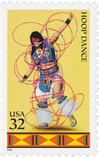
# 3076 - 1996 32c American Indian Dances: Hoop Dance
US #3076
1996 Hoop Dance
- Part of set of 5 picturing traditional dances
- Dances represent tribes from all over US
Stamp Category: Commemorative
Set: American Indian Dances
Value: 32¢, First-Class mail rate
First Day of Issue: June 7, 1996
First Day City: Oklahoma City, Oklahoma
Quantity Issued: 27,850,000
Printed by: Ashton-Potter (USA) Ltd.
Printing Method: Lithographed
Format: Panes of 20 (5 across, 4 down) from printing plates of 120 (8 across, 15 down)
Perforations: 11.1
Why the stamp was issued: This stamp is part of a set of five stamps issued to pay tribute to traditional Native American dances. The dances were chosen to represent different areas of the US.
About the stamp design: Keith Birdsong, an illustrator from Oklahoma, painted the stamp images using airbrush, acrylic, and colored pencils. These were the first stamp images Birdsong produced for the USPS, though he had previously designed souvenir envelopes.
The artist based his artwork for the American Indian Dance stamps on photos of dancers. The faces and costume details were changed to prevent portraying a living person on the stamp. The dances include: Fancy Dance, Butterfly Dance, Traditional Dance, Raven Dance, and Hoop Dance.
Special design details: The band at the bottom of each stamp is from digital clip art. USPS art director Carl Herrman added color to the black-and-white clip art.
First Day City: The First Day of Issue ceremony took place on the opening day of the Red Earth Native American Cultural Festival held in Oklahoma City. The festival includes juried art and dance competitions.
About the American Indian Dances set: The cultural heritage of Native Americans was celebrated on these stamps featuring five American Indian dances - the Fancy Dance, Butterfly Dance, Traditional Dance, Raven Dance, and Hoop Dance. The Traditional, Fancy, and Hoop dances are attributed to many tribes across the United States and are primarily performed at pow-wows. A ceremonial dance, the Raven Dance is only performed in the Pacific Northwest, while the Butterfly is performed by Southwest Pueblo tribes. Each stamp shows a Native American in traditional dress for each dance.
History the stamps represent: Hoop Dance: A 20th-century dance designed strictly for entertaining non-Indian audiences, the Hoop Dance is a showy, crowd-pleasing spectacular. Performed solo or in pairs, the dancer manipulates a dozen or more whirling hoops over and around his torso, legs, and arms, creating designs that represent elements of nature such as birds, turtles, and the earth. The Hoop Dance, performed to the beat of the drum but no song, requires acrobatic skill, quick footwork, and years of practice.
US #3076
1996 Hoop Dance
- Part of set of 5 picturing traditional dances
- Dances represent tribes from all over US
Stamp Category: Commemorative
Set: American Indian Dances
Value: 32¢, First-Class mail rate
First Day of Issue: June 7, 1996
First Day City: Oklahoma City, Oklahoma
Quantity Issued: 27,850,000
Printed by: Ashton-Potter (USA) Ltd.
Printing Method: Lithographed
Format: Panes of 20 (5 across, 4 down) from printing plates of 120 (8 across, 15 down)
Perforations: 11.1
Why the stamp was issued: This stamp is part of a set of five stamps issued to pay tribute to traditional Native American dances. The dances were chosen to represent different areas of the US.
About the stamp design: Keith Birdsong, an illustrator from Oklahoma, painted the stamp images using airbrush, acrylic, and colored pencils. These were the first stamp images Birdsong produced for the USPS, though he had previously designed souvenir envelopes.
The artist based his artwork for the American Indian Dance stamps on photos of dancers. The faces and costume details were changed to prevent portraying a living person on the stamp. The dances include: Fancy Dance, Butterfly Dance, Traditional Dance, Raven Dance, and Hoop Dance.
Special design details: The band at the bottom of each stamp is from digital clip art. USPS art director Carl Herrman added color to the black-and-white clip art.
First Day City: The First Day of Issue ceremony took place on the opening day of the Red Earth Native American Cultural Festival held in Oklahoma City. The festival includes juried art and dance competitions.
About the American Indian Dances set: The cultural heritage of Native Americans was celebrated on these stamps featuring five American Indian dances - the Fancy Dance, Butterfly Dance, Traditional Dance, Raven Dance, and Hoop Dance. The Traditional, Fancy, and Hoop dances are attributed to many tribes across the United States and are primarily performed at pow-wows. A ceremonial dance, the Raven Dance is only performed in the Pacific Northwest, while the Butterfly is performed by Southwest Pueblo tribes. Each stamp shows a Native American in traditional dress for each dance.
History the stamps represent: Hoop Dance: A 20th-century dance designed strictly for entertaining non-Indian audiences, the Hoop Dance is a showy, crowd-pleasing spectacular. Performed solo or in pairs, the dancer manipulates a dozen or more whirling hoops over and around his torso, legs, and arms, creating designs that represent elements of nature such as birds, turtles, and the earth. The Hoop Dance, performed to the beat of the drum but no song, requires acrobatic skill, quick footwork, and years of practice.













